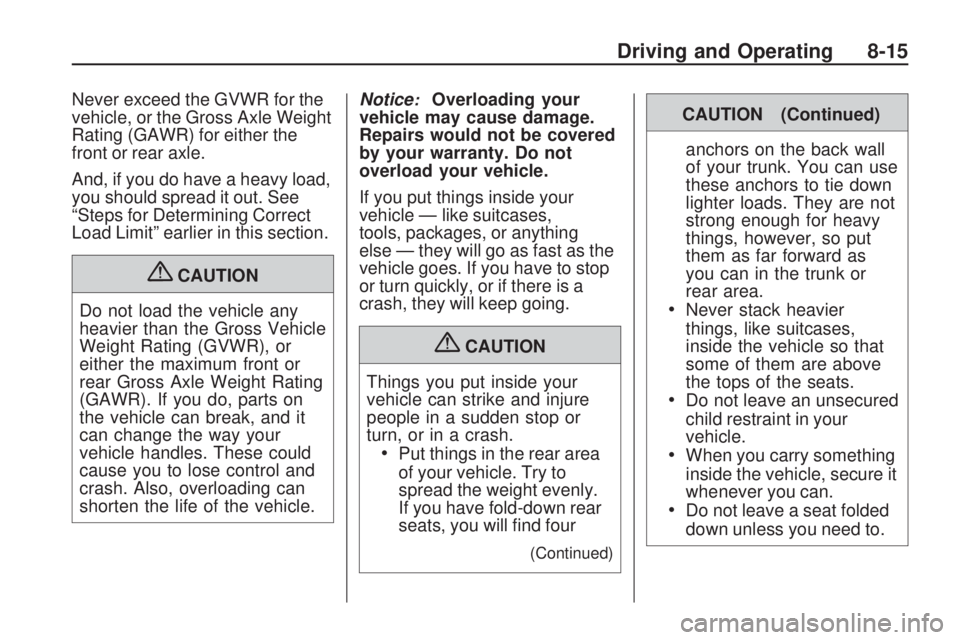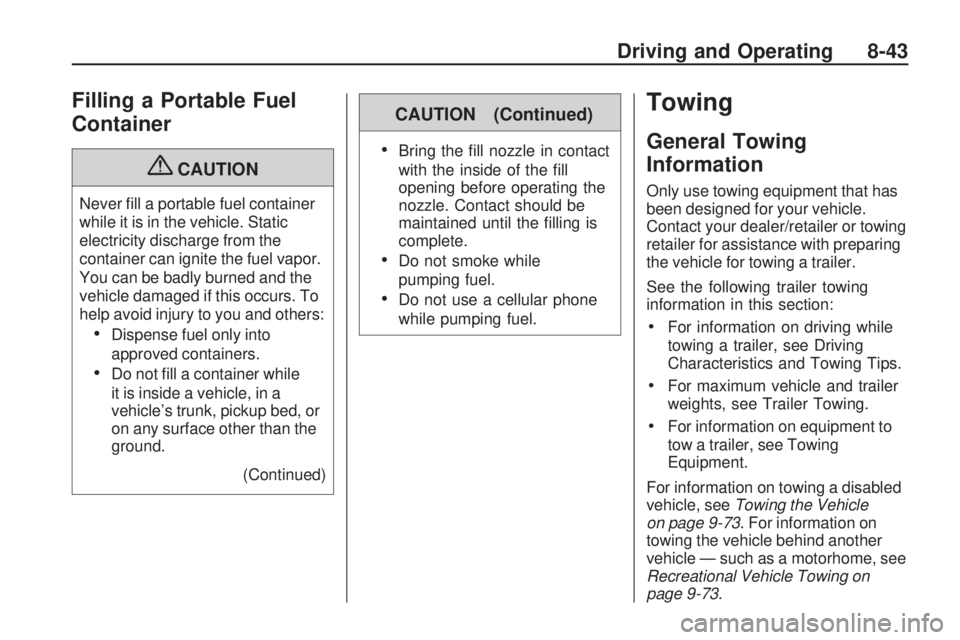Page 12 of 318

Power Door Locks
On vehicles with this feature, the
power door lock switch is located on
the armrest of the driver and front
passenger door.
Q:Press to lock all the doors.
K:Press to unlock all the doors.
Safety Locks
Rear door security locks prevent
passengers from opening the
rear doors from the inside.
Open the rear doors to access the
security locks.
To set these locks, slide the lever
down on each door and close it.
The doors can only be opened from
outside with the door unlocked.
To return the doors to normal
operation, slide the lever up.
Doors
Liftgate
{CAUTION
Exhaust gases can enter the
vehicle if it is driven with the
liftgate, trunk/hatch open, or with
any objects that pass through the
seal between the body and the
trunk/hatch or liftgate. Engine
exhaust contains Carbon
Monoxide (CO) which cannot be
seen or smelled. It can cause
unconsciousness and even death.
If the vehicle must be driven with
the liftgate, or trunk/hatch open:
•Close all of the windows.
•Fully open the air outlets on or
under the instrument panel.
(Continued)
1-6 Keys, Doors and Windows
Page 149 of 318

Never exceed the GVWR for the
vehicle, or the Gross Axle Weight
Rating (GAWR) for either the
front or rear axle.
And, if you do have a heavy load,
you should spread it out. See
“Steps for Determining Correct
Load Limit” earlier in this section.
{CAUTION
Do not load the vehicle any
heavier than the Gross Vehicle
Weight Rating (GVWR), or
either the maximum front or
rear Gross Axle Weight Rating
(GAWR). If you do, parts on
the vehicle can break, and it
can change the way your
vehicle handles. These could
cause you to lose control and
crash. Also, overloading can
shorten the life of the vehicle. Notice
:Overloading your
vehicle may cause damage.
Repairs would not be covered
by your warranty. Do not
overload your vehicle.
If you put things inside your
vehicle — like suitcases,
tools, packages, or anything
else — they will go as fast as the
vehicle goes. If you have to stop
or turn quickly, or if there is a
crash, they will keep going.
{CAUTION
Things you put inside your
vehicle can strike and injure
people in a sudden stop or
turn, or in a crash.
•Put things in the rear area
of your vehicle. Try to
spread the weight evenly.
If you have fold-down rear
seats, you will find four
(Continued)
CAUTION (Continued) anchors on the back wall
of your trunk. You can use
these anchors to tie down
lighter loads. They are not
strong enough for heavy
things, however, so put
them as far forward as
you can in the trunk or
rear area.
•Never stack heavier
things, like suitcases,
inside the vehicle so that
some of them are above
the tops of the seats.
•Do not leave an unsecured
child restraint in your
vehicle.
•When you carry something
inside the vehicle, secure it
whenever you can.
•Do not leave a seat folded
down unless you need to.
Driving and Operating 8-15
Page 177 of 318

Filling a Portable Fuel
Container
{CAUTION
Never fill a portable fuel container
while it is in the vehicle. Static
electricity discharge from the
container can ignite the fuel vapor.
You can be badly burned and the
vehicle damaged if this occurs. To
help avoid injury to you and others:
•Dispense fuel only into
approved containers.
•Do not fill a container while
it is inside a vehicle, in a
vehicle’s trunk, pickup bed, or
on any surface other than the
ground.(Continued)
CAUTION (Continued)
•Bring the fill nozzle in contact
with the inside of the fill
opening before operating the
nozzle. Contact should be
maintained until the filling is
complete.
•Do not smoke while
pumping fuel.
•Do not use a cellular phone
while pumping fuel.
Towing
General Towing
Information
Only use towing equipment that has
been designed for your vehicle.
Contact your dealer/retailer or towing
retailer for assistance with preparing
the vehicle for towing a trailer.
See the following trailer towing
information in this section:
•For information on driving while
towing a trailer, see Driving
Characteristics and Towing Tips.
•For maximum vehicle and trailer
weights, see Trailer Towing.
•For information on equipment to
tow a trailer, see Towing
Equipment.
For information on towing a disabled
vehicle, see Towing the Vehicle
on page 9-73. For information on
towing the vehicle behind another
vehicle — such as a motorhome, see
Recreational Vehicle Towing on
page 9-73.
Driving and Operating 8-43